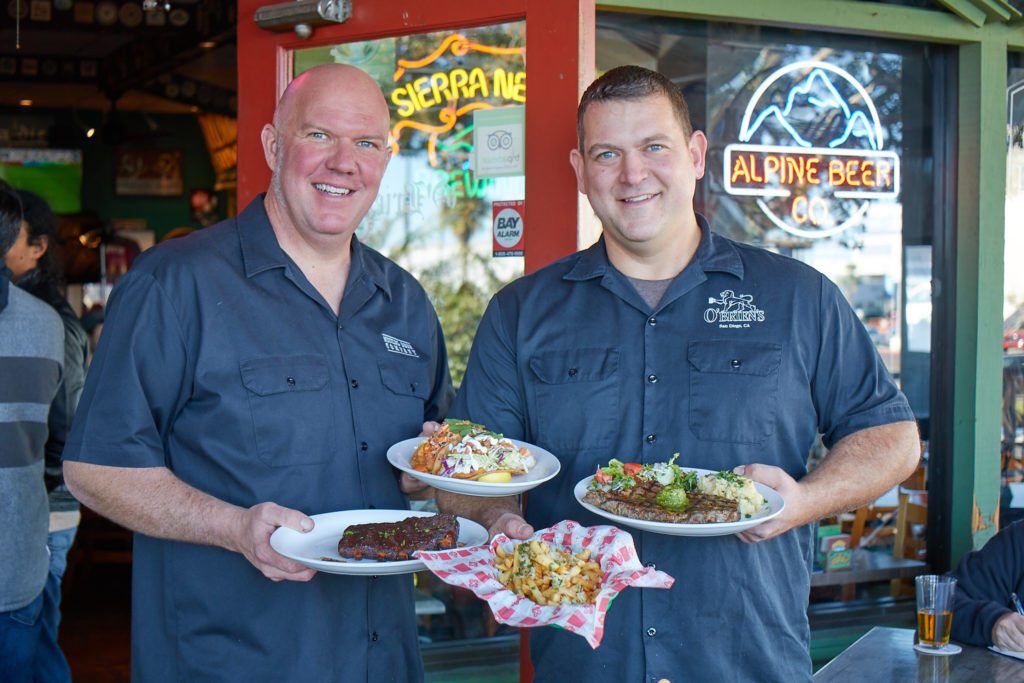“Legendary” gets thrown around like a convention tchotchke these days. That new turmeric shake at that Instagram place? Legendary. A bit much. Yet “famed” feels a bit too Will Smith. And so we go with the more bold typeface “iconic.” Or we delve deeper into the thesaurus and apply “seminal.”
I’m staring at 28 taps at O’Brien’s Pub. Every single one of them dispensing some of the very best, meticulously selected craft beer in the business. Sure, that’s commonplace now. But it wasn’t when Jim O’Brien took over the spot (then a German lunch spot called Ingrid’s Delicatessen) in 1994. Nor when Tom Nickel took it over in 2003. Craft beer was just something yeast and hop nerds did in warehouses. By the time co-owner Tyson Blake got here in 2010, it was a regional attraction.
When it comes to craft beer—a major part of San Diego’s identity for the last couple of decades—this little corner spot in a Kearny Mesa strip mall is for sure seminal (the first place that served big craft-beer names like Alesmith, Pizza Port, Alpine, Green Flash, etc.). Definitely iconic (it was the spot Russian River launched in San Diego). More legendary than most.
This weekend, pandemic loosening its dirty grip, O’Brien’s celebrates 27 (and a half) years. They do it the way they always do it. With “TION,” for which their friends at iconic legendary brewery Russian River (even casual beer fans have probably heard of Pliny the Elder) sends down 20 kegs of specialized beers (the names of which all end in TION)—Pliny, Blind Big, Citra Flash Mob, Beatification, ten sour ales, you name it. O’Briens and Toronado in San Francisco are the only two places in the country where this happens.
“About 1996 was the national craft beer explosion, but that didn’t really hit here in San Diego—even when I took over, it was very much still a Coors Light town,” says Nickel, sitting on his patio with Blake. “We’d go to craft beer conventions in Arizona and they’d say, ‘Oh my god you guys make such amazing beer in San Diego thanks for coming!’ But we’d never get that reaction in San Diego. We still had to convince people.”
Nickel—who now runs Nickel Beer Co. in Julian—is a force, a living lexicon of craft beer’s ascent. He got a degree in Medieval History from Yale, started home brewing at age 18. Worked at Home Brew Mart—arguably the birthplace of all things craft beer in San Diego. He was there when Ballast Point launched. Beer in hand, he recants exact dates and arcane historical facts (“You had the class of ’96—Coronado Brewing, Ballast Point, and Stone. Alesmith opened in ’95, Pizza Port was ’92, Karl Strauss was ’89.”) In between thoughts, he appears to be doing sudoku in his head.
“In the beginning, menus still had beers divided into ‘Domestic’ and ‘Imported,’” he says. “There was no craft beer section. So Sierra Nevada and Sam Adams were on the Imported list because that’s how much they cost.’”
When doing our cover story on how Convoy became the epicenter of Asian food culture, at least four Asian business owners suggested I talk to “Tyson over at O’Brien’s.” One referred to him as “our honorary Asian,” told stories of how Blake helped local business owners who didn’t speak great English navigate the paperwork for PPP and pandemic relief packages, of how crucial he’s been over the years. The cover story became a history of Asian heritage, and an Irish American Pub didn’t easily fit. I ran into Blake on the beach a few days later. I apologized for his exclusion. He cheerily waved off any concerns.
“You got the important story,” he said, with trademark humility that tends to make him everyone’s instant friend. “We’re an English American pub in the middle of a great Asian food town.”
And yet by being seminal iconic legendary in craft beer, O’Brien’s helped build that food town. O’Brien’s—along with San Diego Beer Company and Callahan’s—was one of a couple places early fans of IPAs and hoppy alternatives to mainstream beer. When craft beer started, breweries were only selling their own beer. O’Brien’s brought them all under one roof, serving beers many early aficionados had only read about on the internet or tasted at festivals. And so, by flocking here for a Pliny or a Delirium Tremens, they discovered bibimbap and ramen and bulgogi.
It’s Blake that orchestrates the beer-pairing dinners—the art form of which he’s turned into a sort of magic trick. For instance, I’m about to try O’Brien’s famous Birthday Bacon (thick slab bacon slow-braised in beer). Blake wants me to try it with an Eppig Smoked Helles Lager. I go to take a bite of the bacon and he sticks his significantly strong hand in front of my fork.
“No!” he says. “Once you taste the bacon, that smokey flavor will cancel out the smokey flavor in the beer. Taste the beer first, then the bacon, and then the beer again. It’ll taste like two different beers, because the bacon will open all the other flavors.”
He’s right. At first sip I taste that oaky smoke. Then I try the bacon (delicious), and take another sip. The smoke is gone—lost under the campfire from the bacon—and I taste toasted bread.
“It’s those small things,” Blake says. “If I can help someone see that—and then they’re going to go to their friend, husband, or wife and want to show them that experience and that will change the way they drink beer from now on. We have people tell us ‘I never would’ve tried that beer, but when I learned it went with this certain food, now I’ll order it.’”
PARTNER CONTENT
This is how O’Briens is still thriving, even in an age where Applebees has craft suds. They helped start a city’s craft beer scene. They made upstart brewers in a fledgling scene into rock stars. They invested in the food (longtime chef Humberto is now a partner at their La Mesa restaurant, West Coast Smoke & Tap House). Those early craft beer fans who came to Convoy for O’Brien’s discovered Asian food. And now people coming to Convoy for Asian food are discovering O’Brien’s seminal iconic legendary status in craft beer.
TION goes on all weekend at O’Briens. 4646 Convoy St.


















